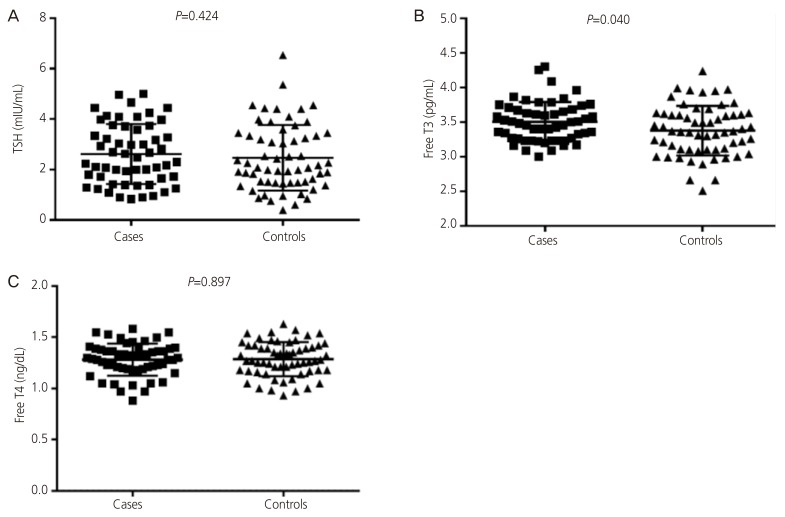Obstet Gynecol Sci.
2017 Mar;60(2):187-192. 10.5468/ogs.2017.60.2.187.
Thyroid function/antibodies in sudanese women with polycystic ovarian disease
- Affiliations
-
- 1Faculty of Medicine and Health Sciences, Al-Neelain University, Khartoum, Sudan.
- 2Faculty of Medicine, University of Khartoum, Khartoum, Sudan. ishagadam@hotmail.com
- KMID: 2372803
- DOI: http://doi.org/10.5468/ogs.2017.60.2.187
Abstract
OBJECTIVE
To evaluate thyroid function and hormonal profile in women with polycystic ovary syndrome (PCOS).
METHODS
A case-control study was conducted at Saad Abualila Center, Khartoum, Sudan. The cases were women with confirmed PCOS based on Rotterdam criteria. The controls were infertile women with no evidence of PCOS. The socio-demographic characteristics and medical history were gathered using a questionnaire. Thyroid hormones (thyroid-stimulating hormone, free tri-iodothyronine, and free thyroxine), anti-thyroid peroxidase, and anti-thyroglobulin antibodies were measured.
RESULTS
While there were no significant differences in the age and haemoglobin levels of the two studied groups (55 women in each arm), body mass index was significantly higher in women with PCOS. There were no significant differences in the levels of thyroid-stimulating hormone, luteinizing hormone, follicle stimulating hormone, luteinizing hormone/follicle stimulating hormone, anti-thyroid peroxidase, anti-thyroglobulin antibodies, cholesterol, triglycerides and low-density lipoprotein cholesterol between the cases and the controls. The mean±standard deviation of free tri-iodothyronine (3.50±0.2 vs. 3.38±0.3 pg/mL, P=0.040) and median (interquartile) high-density lipoprotein cholesterol (37.0 [34.0 to 42.0] vs. 35.80 [29.0 to 41.0] mg/dL, P=0.015) were significantly higher in PCOS patients compared with the control group. In linear regression, PCOS (0.151 pg/mL, P=0.023) and anti-thyroid peroxidase levels (-0.078 pg/mL, P=0.031) were significantly associated with free tri-iodothyronine.
CONCLUSION
Free tri-iodothyronine was a significantly higher among PCOS patients compared with the control group.
Keyword
MeSH Terms
-
Antibodies
Body Mass Index
Case-Control Studies
Cholesterol
Female
Follicle Stimulating Hormone
Humans
Infertility
Linear Models
Lipoproteins
Lutein
Luteinizing Hormone
Ovarian Diseases*
Peroxidase
Polycystic Ovary Syndrome
Sudan
Thyroid Gland*
Thyroid Hormones
Thyrotropin
Triglycerides
Antibodies
Cholesterol
Follicle Stimulating Hormone
Lipoproteins
Lutein
Luteinizing Hormone
Peroxidase
Thyroid Hormones
Thyrotropin
Triglycerides
Figure
Reference
-
1. Sirmans SM, Pate KA. Epidemiology, diagnosis, and management of polycystic ovary syndrome. Clin Epidemiol. 2013; 6:1–13. PMID: 24379699.
Article2. Witchel SF, Oberfield S, Rosenfield RL, Codner E, Bonny A, Ibanez L, et al. The diagnosis of polycystic ovary syndrome during adolescence. Horm Res Paediatr. 2015; 4. 01. DOI: 10.1159/000375530. [Epub].
Article3. Rotterdam ESHRE/ASRM-Sponsored PCOS Consensus Workshop Group. Revised 2003 consensus on diagnostic criteria and long-term health risks related to polycystic ovary syndrome. Fertil Steril. 2004; 81:19–25.4. Expert Panel on Detection, Evaluation, and Treatment of High Blood Cholesterol in Adults. Executive summary of the third report of the National Cholesterol Education Program (NCEP) Expert Panel on Detection, Evaluation, and Treatment of High Blood Cholesterol in Adults (Adult Treatment Panel III). JAMA. 2001; 285:2486–2497. PMID: 11368702.5. Ramanand SJ, Ghongane BB, Ramanand JB, Patwardhan MH, Ghanghas RR, Jain SS. Clinical characteristics of polycystic ovary syndrome in Indian women. Indian J Endocrinol Metab. 2013; 17:138–145. PMID: 23776867.
Article6. Janssen OE, Mehlmauer N, Hahn S, Offner AH, Gartner R. High prevalence of autoimmune thyroiditis in patients with polycystic ovary syndrome. Eur J Endocrinol. 2004; 150:363–369. PMID: 15012623.
Article7. Sinha U, Sinharay K, Saha S, Longkumer TA, Baul SN, Pal SK. Thyroid disorders in polycystic ovarian syndrome subjects: a tertiary hospital based cross-sectional study from Eastern India. Indian J Endocrinol Metab. 2013; 17:304–309. PMID: 23776908.
Article8. Nisar S, Shah PA, Kuchay MS, Bhat MA, Rashid A, Ahmed S, et al. Association of polycystic ovary syndrome and Graves' disease: is autoimmunity the link between the two diseases. Indian J Endocrinol Metab. 2012; 16:982–986. PMID: 23226647.9. Jung JH, Hahm JR, Jung TS, Kim HJ, Kim HS, Kim S, et al. A 27-year-old woman diagnosed as polycystic ovary syndrome associated with Graves' disease. Intern Med. 2011; 50:2185–2189. PMID: 21963738.
Article10. Moran C, Arriaga M, Arechavaleta-Velasco F, Moran S. Adrenal androgen excess and body mass index in polycystic ovary syndrome. J Clin Endocrinol Metab. 2015; 1. 07. DOI: 10.1210/jc.0000-9999. [Epub].
Article11. Elussein EA, Magid YM, Omer MM, Adam I. Clinical patterns and major causes of infertility among Sudanese couples. Trop Doct. 2008; 38:243–244. PMID: 18820200.
Article12. Ahmed M, Shareef O, Adam I, Rayis D. Maternal age and intracytoplasmic sperm injection outcome in infertile couples at Khartoum, Sudan. F1000Res. 2015; 4:1339. PMID: 27347370.
Article13. Elhaj ET, Adam I, Alim A, Elhassan EM, Lutfi MF. Thyroid function/antibodies in Sudanese patients with preeclampsia. Front Endocrinol (Lausanne). 2015; 6:87. PMID: 26124747.
Article14. Wu X, Zhang Z, Su Y. Functional states of pituitary-ovary, adrenal and thyroid axes in women with polycystic ovarian syndrome. Zhonghua Fu Chan Ke Za Zhi. 1998; 33:153–156. PMID: 10682483.15. Zironi C, Pantaleoni M, Zizzo G, Coletta F, Velardo A. Evaluation of dopaminergic activity of the hypothalamus in patients with polycystic ovarian syndrome. Minerva Ginecol. 1991; 43:443–447. PMID: 1685015.16. Gulekli B, Turhan NO, Senoz S, Kukner S, Oral H, Gokmen O. Endocrinological, ultrasonographic and clinical findings in adolescent and adult polycystic ovary patients: a comparative study. Gynecol Endocrinol. 1993; 7:273–277. PMID: 8147237.17. Tudose TI, Zelenetskaia VS, Kozlov GI, Pishchulin AA, Dobracheva AD. Lactotropic and thyrotropic functions of the hypophysis in polycystic ovary syndrome. Probl Endokrinol (Mosk). 1986; 32:3–7.18. Lin JF, Li X, Zhu MW. Exploration of the classification of polycystic ovarian syndrome. Zhonghua Fu Chan Ke Za Zhi. 2006; 41:684–688. PMID: 17199924.19. Lim SS, Norman RJ, Davies MJ, Moran LJ. The effect of obesity on polycystic ovary syndrome: a systematic review and meta-analysis. Obes Rev. 2013; 14:95–109. PMID: 23114091.
Article
- Full Text Links
- Actions
-
Cited
- CITED
-
- Close
- Share
- Similar articles
-
- Thyroid dysfunction and subfertility
- Inter-ovarian differences in ultrasound markers of ovarian size in women with polycystic ovary syndrome
- Effects of Metformin and Rosiglitazone in Overweight or Obese Women with Polycystic Ovarian Syndrome
- Circulating antibodies directed toward ovarian proteins in women with premature ovarian failure
- Influence of combined oral contraceptives on polycystic ovarian morphology-related parameters in Korean women with polycystic ovary syndrome


